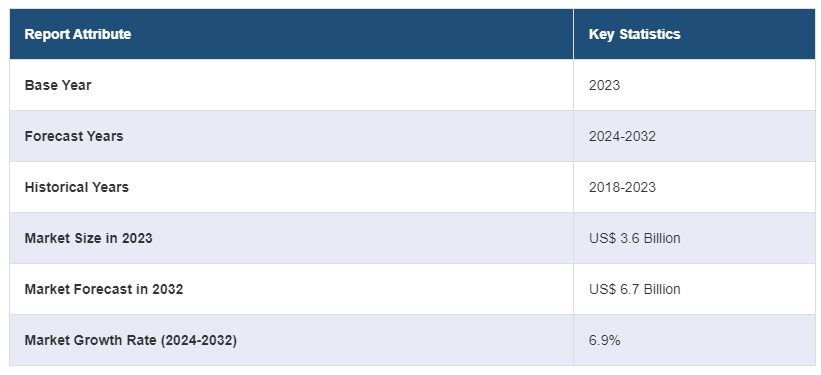| 글로벌 열차 제어 관리 시스템 시장은 2023년 기준으로 약 36억 달러에 달하며, 2032년까지 67억 달러에 이를 것으로 예상되며, 이 기간 동안 연평균 성장률(CAGR)은 6.9%에 이를 것으로 전망되고 있습니다. 열차 제어 관리 시스템(TCMS)은 열차와 하위 시스템 간의 정보 흐름을 관리하기 위해 사용되는 중앙 집중식 제어 시스템으로, 소프트웨어, 인간-기계 인터페이스, 디지털 및 아날로그 입출력 시스템, 데이터 네트워크 등 다양한 컴퓨터 기반 솔루션으로 구성됩니다. 모바일 통신 게이트웨이는 저비용 고대역폭 채널을 활용하여 기차 위치를 제공하며, TCMS는 자동화된 배수문, 공조기 및 환기 시스템 간의 보안되고 상호 연결된 통신 인터페이스를 제공하여 메트로, 트램, 다중 차량 열차 등에서 결함을 예방하는 데 도움을 줍니다. 시장 성장의 주요 요인은 전 세계적으로 진행되고 있는 철도 시스템의 빠른 디지털화입니다. 고속 통신 시스템의 증가로 인해 시장 성장에 긍정적인 영향을 미치고 있으며, 안전하고 효율적인 교통 시스템에 대한 요구 증가로 인해 자동화된 메트로와 고속 열차에 정교한 온보드 카메라, 센서 및 통신 장치가 통합되고 있습니다. 또한, 산업용 사물인터넷(IIoT), 인공지능(AI), 빅데이터 및 머신러닝(ML)과 같은 기술적 발전이 시장 성장의 또 다른 요인으로 작용하고 있습니다. 이 외에도 이동 서비스(MaaS) 비즈니스 모델의 광범위한 도입과 철도 인프라의 개선이 시장 성장을 이끌 것으로 예상됩니다. IMARC 그룹은 글로벌 열차 제어 관리 시스템 시장의 주요 트렌드를 분석하고 있으며, 구성요소, 솔루션 유형, 네트워크 유형 및 열차 유형에 따라 시장을 세분화하고 있습니다. 구성 요소별로는 차량 제어 장치, 모바일 통신 게이트웨이, 인간-기계 인터페이스 등이 포함되며, 솔루션 유형으로는 통신 기반 열차 제어, 포지티브 열차 제어, 통합 열차 제어 등이 있습니다. 네트워크 유형에 따라 이더넷 구성 네트워크, 다기능 차량 버스, 유선 열차 버스 등이 있으며, 열차 유형으로는 지하철 및 고속 열차, 전기 다중 유닛, 디젤 다중 장치 등이 있습니다. 경쟁 환경에서는 주요 기업으로 알스톰, 아셀산, 봄바르디어, EKE 전자, 제너럴 일렉트릭, 히타치, 크노르 브렘세, 메다 서보 드라이브, 미쓰비시 전기, 지멘스, 탈레스 그룹 등이 있으며, 이들 기업의 시장 점유율과 경쟁력을 분석하고 있습니다. |
The global train control management system market size reached US$ 3.6 Billion in 2023. Looking forward, IMARC Group expects the market to reach US$ 6.7 Billion by 2032, exhibiting a growth rate (CAGR) of 6.9% during 2024-2032.
Report Attribute
Key Statistics
Base Year
2023
Forecast Years
2024-2032
Historical Years
2018-2023
Market Size in 2023
US$ 3.6 Billion
Market Forecast in 2032
US$ 6.7 Billion
Market Growth Rate (2024-2032) 6.9%
Train control management system (TCMS) is a centralized control system used to manage the flow of information between the trains and subsystems. It consists of various computer-based solutions, such as software, human-machine interface, digital and analog input/output (I/O) system and data networks. The mobile communication gateways (MCGs) use Wi-fi and global positioning system (GPS) solutions to utilize low-cost and high-bandwidth channels for providing train location to onboard and station systems. TCMS provides a secure and interconnected communication interface between automatic drain doors, air conditioners and ventilation systems, and aids in preventing faults in metros, trams, multiple-car trains, high-performance locomotives and high-speed trains. In comparison to the traditionally used standalone systems, TCMS integrates the data from multiple sources and provides more efficient services to locomotive drivers, maintainers and passengers.
Train Control Management System Market Trends:
Rapid digitization of the railway systems across the globe is one of the key factors creating a positive outlook for the market. Moreover, the increasing availability of high-speed communication systems is providing a thrust to the market growth. With the rising requirement for secure, safe and efficient transportation systems, both underground and ground-level locomotives, including automated metros and high-speed trains, are integrated with sophisticated onboard cameras, sensors and communication devices. Additionally, various technological advancements, such as the integration of connected devices with the Industrial Internet of Things (IIoT), artificial intelligence (AI), big data and machine learning (ML) solutions, are acting as other growth-inducing factors. These solutions are also connected with cloud computing and cyber security solutions to operate smart signaling, real-time train planning, route scheduling and centralized controlling systems. Other factors, including the widespread adoption of Mobility-as-a-Service (MaaS) business models, along with significant improvements in railway infrastructure, are anticipated to drive the market toward growth.
Key Market Segmentation:
IMARC Group provides an analysis of the key trends in each sub-segment of the global train control management system market, along with forecasts at the global, regional and country level from 2024-2032. Our report has categorized the market based on component, solution type, network type, and train type.
Breakup by Component:
Vehicle Control Unit
Mobile Communication Gateway
Human–machine Interface
Others
Breakup by Solution Type:
Communication-based Train Control
Positive Train Control
Integrated Train Control
Breakup by Network Type:
Ethernet Consist Network
Multifunctional Vehicle Bus
Wired Train Bus
Breakup by Train Type:
Metros and High-speed Trains
Electric Multiple Units
Diesel Multiple Units
Breakup by Region:
North America
United States
Canada
Asia-Pacific
China
Japan
India
South Korea
Australia
Indonesia
Others
Europe
Germany
France
United Kingdom
Italy
Spain
Russia
Others
Latin America
Brazil
Mexico
Others
Middle East and Africa
Competitive Landscape:
The competitive landscape of the industry has also been examined along with the profiles of the key players being Alstom, Aselsan A., Bombardier Inc., Construcciones y Auxiliar de Ferrocarriles S.A., EKE-Electronics Ltd, General Electric Company, Hitachi Ltd., Knorr-Bremse Systeme für Schienenfahrzeuge GmbH, Medha Servo Drives Private Limited, Mitsubishi Electric Corporation, Siemens AG, and Thales Group.

1 머리말
2 연구 범위 및 방법론
2.1 연구 목적
2.2 이해관계자
2.3 데이터 출처
2.3.1 1차 출처
2.3.2 보조 출처
2.4 시장 추정
2.4.1 상향식 접근 방식
2.4.2 하향식 접근 방식
2.5 예측 방법론
3 요약
4 소개
4.1 개요
4.2 주요 산업 동향
5 글로벌 열차 제어 관리 시스템 시장
5.1 시장 개요
5.2 시장 성과
5.3 COVID-19의 영향
5.4 시장 전망
6 구성 요소 별 시장 세분화
6.1 차량 제어 장치
6.1.1 시장 동향
6.1.2 시장 전망
6.2 모바일 통신 게이트웨이
6.2.1 시장 동향
6.2.2 시장 전망
6.3 인간-기계 인터페이스
6.3.1 시장 동향
6.3.2 시장 전망
6.4 기타
6.4.1 시장 동향
6.4.2 시장 전망
7 솔루션 유형별 시장 세분화
7.1 통신 기반 열차 제어
7.1.1 시장 동향
7.1.2 시장 전망
7.2 포지티브 열차 제어
7.2.1 시장 동향
7.2.2 시장 예측
7.3 통합 열차 제어
7.3.1 시장 동향
7.3.2 시장 예측
8 네트워크 유형별 시장 세분화
8.1 이더넷 구성 네트워크
8.1.1 시장 동향
8.1.2 시장 예측
8.2 다기능 차량 버스
8.2.1 시장 동향
8.2.2 시장 예측
8.3 유선 열차 버스
8.3.1 시장 동향
8.3.2 시장 예측
9 열차 유형별 시장 세분화
9.1 지하철 및 고속 열차
9.1.1 시장 동향
9.1.2 시장 예측
9.2 전기 다중 유닛
9.2.1 시장 동향
9.2.2 시장 예측
9.3 디젤 다중 장치
9.3.1 시장 동향
9.3.2 시장 전망
10 지역별 시장 세분화
10.1 북미
10.1.1 미국
10.1.1.1 시장 동향
10.1.1.2 시장 예측
10.1.2 캐나다
10.1.2.1 시장 동향
10.1.2.2 시장 예측
10.2 아시아 태평양
10.2.1 중국
10.2.1.1 시장 동향
10.2.1.2 시장 예측
10.2.2 일본
10.2.2.1 시장 동향
10.2.2.2 시장 예측
10.2.3 인도
10.2.3.1 시장 동향
10.2.3.2 시장 예측
10.2.4 대한민국
10.2.4.1 시장 동향
10.2.4.2 시장 예측
10.2.5 호주
10.2.5.1 시장 동향
10.2.5.2 시장 전망
10.2.6 인도네시아
10.2.6.1 시장 동향
10.2.6.2 시장 예측
10.2.7 기타
10.2.7.1 시장 동향
10.2.7.2 시장 예측
10.3 유럽
10.3.1 독일
10.3.1.1 시장 동향
10.3.1.2 시장 예측
10.3.2 프랑스
10.3.2.1 시장 동향
10.3.2.2 시장 예측
10.3.3 영국
10.3.3.1 시장 동향
10.3.3.2 시장 예측
10.3.4 이탈리아
10.3.4.1 시장 동향
10.3.4.2 시장 전망
10.3.5 스페인
10.3.5.1 시장 동향
10.3.5.2 시장 예측
10.3.6 러시아
10.3.6.1 시장 동향
10.3.6.2 시장 예측
10.3.7 기타
10.3.7.1 시장 동향
10.3.7.2 시장 예측
10.4 라틴 아메리카
10.4.1 브라질
10.4.1.1 시장 동향
10.4.1.2 시장 예측
10.4.2 멕시코
10.4.2.1 시장 동향
10.4.2.2 시장 예측
10.4.3 기타
10.4.3.1 시장 동향
10.4.3.2 시장 예측
10.5 중동 및 아프리카
10.5.1 시장 동향
10.5.2 국가 별 시장 세분화
10.5.3 시장 예측
11 SWOT 분석
11.1 개요
11.2 강점
11.3 약점
11.4 기회
11.5 위협
12 가치 사슬 분석
13 포터의 다섯 가지 힘 분석
13.1 개요
13.2 구매자의 협상력
13.3 공급자의 협상력
13.4 경쟁의 정도
13.5 신규 진입자의 위협
13.6 대체재의 위협
14 가격 분석
15 경쟁 환경
15.1 시장 구조
15.2 주요 플레이어
